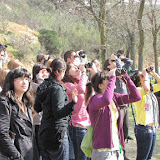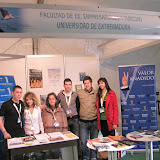
WE went on a demonstration to save the most important wintering area for Common Crane (
grus grus, Sp.
grulla común) in Extremadura (Spain), using the Via Verde to walk from Madrigalejo to the Casas de Hito reservoir. It was organized by
SEO/BirdLife.

The regional authorities have approved a development of a huge two-solar power plant project (one will fill up the entire rice-field background behind some of the birdwatchers/ demonstrators above). We wonder whether the regional authorities want them as the new hip on a nice "green" type of scenery, the panels to be built. These solar panels will literally wall this birdwatching/walking tract of the Via Verde (Spanish for "greenway"), the only one in Extremadura?! For God's sake, it is a
ZEPA, Spanish for
SPA, the area we are talking about.
BESIDE the solar farm themselves, what about the power lines to be built from there to Valdecaballeros (in the Extremadura southern province of Badajoz). Isn't Extremadura one of the less populated regions in Europe (26/km2)? An area of a quarter bigger than Belgium (density 345/km2). There is so much space for clean energy in Extremadura..., c'mon!
POLITICAL wit apart, we were at our scopes and binoculars, watching cranes feeding, others in "V" formation crossing over our heads, and lots of wild fowl on the reservoir, red avadavat and other passerines all around us... when we suddenly saw an osprey approaching. The video and our comments there tell the rest:
An
Osprey finally gets a catch and escapes from a doggedly insistent pair of Black-headed Gull (
Larus ridibundus, Sp.
Gaviota reidora) who were apparently annoyed by its company.

The day ended with an impressive sight, a huge concentration of well over 4,300 Black-tailed Godwit, (
Limosa limosa, Sp.
Aguja colinegra) in the rice fields of the Santa Amalia area. They were in company of a well over a hundred Spotted Redshank (
Tringa erythropus, Sp. A
rchibebe oscuro) concentration (one of the greatest, I am told, ever recorded in Extremadura), some Black-winged Stilt (himantopus himantopus, Sp. cigüeñuela) and Golden Plover in the tens (
pluvialis apricaria, Sp.
Chorlito dorado). The list could never end, anyway. Jesús Porras lead us to them as wisely and wittily as one can. Thanks, Jesús, as always.



















 The day ended with an impressive sight, a huge concentration of well over 4,300 Black-tailed Godwit, (Limosa limosa, Sp. Aguja colinegra) in the rice fields of the Santa Amalia area. They were in company of a well over a hundred Spotted Redshank (Tringa erythropus, Sp. Archibebe oscuro) concentration (one of the greatest, I am told, ever recorded in Extremadura), some Black-winged Stilt (himantopus himantopus, Sp. cigüeñuela) and Golden Plover in the tens (pluvialis apricaria, Sp. Chorlito dorado). The list could never end, anyway. Jesús Porras lead us to them as wisely and wittily as one can. Thanks, Jesús, as always.
The day ended with an impressive sight, a huge concentration of well over 4,300 Black-tailed Godwit, (Limosa limosa, Sp. Aguja colinegra) in the rice fields of the Santa Amalia area. They were in company of a well over a hundred Spotted Redshank (Tringa erythropus, Sp. Archibebe oscuro) concentration (one of the greatest, I am told, ever recorded in Extremadura), some Black-winged Stilt (himantopus himantopus, Sp. cigüeñuela) and Golden Plover in the tens (pluvialis apricaria, Sp. Chorlito dorado). The list could never end, anyway. Jesús Porras lead us to them as wisely and wittily as one can. Thanks, Jesús, as always.



